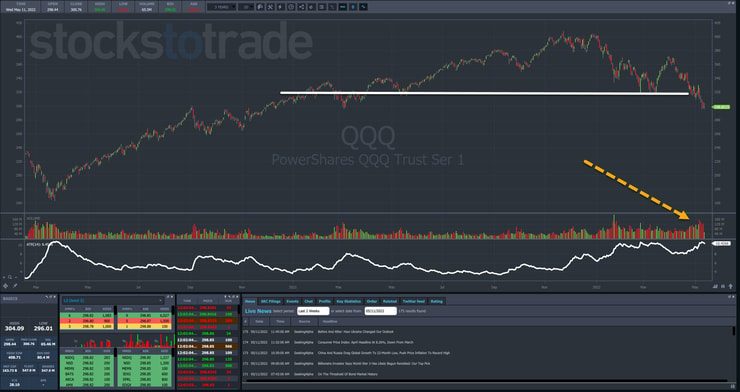Hey Trader. Tim Here.
Last November, I made a bold call — prepare for a market crash.

So far, it’s playing out EXACTLY as I predicted.
Market sell-offs tend to cause businesses to make layoffs and traders to lose money…
…so I’m not happy that I was right about it.
My warning was meant to help people prepare for the dangers I saw coming…
Of course, when you nail a call like that, people want to know what’s next.
What are my current thoughts?
Here’s what I think: The price action doesn’t lie. This market is heading lower.
And just like I tried to protect folks back in November, I’ll do my best here.
Before I continue … I must tell you … my FIRST LIVE IN-PERSON event of the year is a few weeks away, and I have another serious prediction to make…
Table of Contents
Markets Haven’t Found a Bottom
I don’t care that inflation has supposedly ‘peaked’ or that momentum tech stocks are incredibly cheap.
I’ve said it before and I’ll say it again … price action doesn’t lie.
Check out the daily chart for the Invesco QQQ Trust (NASDAQ: QQQ), which tracks the Nasdaq.
The white trendline shows where the markets hit their lows a few months ago.
What happened when we hit that spot in the last few weeks?
The QQQ traded straight sideways for days … then, it slid further on heavy volume.
Yesterday, we talked about panic buying and capitulation.
This isn’t it.
Volume increased but markets didn’t show signs of a reversal.
Instead, they fell and stayed down. All the folks in the ‘buy the dip’ crowd disappeared.
At some point, indexes will violently bounce back. However, to find a true bottom, markets need to create more panic.
That’s why I cut my position size.
Reduce Position Size
KISS = Keep it simple, stupid.
Reduce your position size.
I talk about this every day for one important reason — to remind myself.
It’s so easy to forget that the market is choppier than it was last year, let alone a few weeks ago.
But remembering this is essential to surviving any difficult market.
Plus, when you see larger price swings, you can get the same profits with a smaller size … simply by looking for better targets.
For example, if a stock that trades for $1.00 typically sees a 10% range, it’ll likely trade between $0.90-$1.10.
Now, let’s say volatility doubles, and the stock now trades in a 20% range, or $0.80-$1.20.
I can achieve the same maximum profit (and loss) by cutting my position size in half and widening my target (and stop-loss) by 2x.
Pretty basic stuff.
More Breaking News
- Ichigo Inc. Announces Bold Share Buyback and Renewable Energy Surge: What’s Next?
- Marathon Digital Holdings: Is the Recent Crypto Dip a Buying Opportunity?
- Will IonQ’s Rising Stock Survive the Tech Roller Coaster?
But now, I want to let you in on a little secret…
Test the Waters

Markets will return to ‘normal’ at some point.
But when they do, they might look and feel completely different.
That’s why I’m ‘testing the waters’ with tiny trades every day or so.
These tiny trades help me connect with the market to get a feel for the price action.
Plus, it keeps me involved. That way, when the market does turn, I’ll not only sense it — I’ll be able to participate.
Here’s a good example…
2020 and 2021 were the years of SPACs and meme stocks. They provided some of the best long trading opportunities in a long time.
Now, they’re duds.
Additionally, a lot of the high-flying biotech names have taken a hit.
Just look at electric vehicle stocks, or cryptocurrencies, and notice how poorly they’ve traded over the past month.
When we emerge from this downturn, it’s unlikely these former players will be the new front-runners.
That’s why I continue to watch different indicators including:
- Relative strength
- Sector strength
- Volume
- Recent news
By no means is this a comprehensive list, but it’s a good place to start.
And let me make one more point…
I don’t need to spend a lot of money to test the waters.
Simulated accounts work just fine. Or, I can trade just a few shares.
There is no reason to take normal positions in these test trades. And frankly, it’s bad risk management if you do.
The goal isn’t to make tons of money off of these trades. It’s to prepare yourself to take advantage when the dust settles and clear trends present themselves.
Tools to Help

I want things to be as simple for traders as possible.
That’s why I want to share a few recommendations…
First, the StocksToTrade Breaking News feature is hands down the best. Analysts curate the news, highlighting opportunities and even pointing out chat pumps.
The second is the StocksToTrade Platform itself. It includes some incredible charting features and scans that quickly and effectively identify trading opportunities.
And lastly, my Supernova Pattern.
This pattern helped me earn my first million dollars. But what’s even cooler is that it identifies stocks and sectors seeing huge interest.
Plus, you learn HOW to trade these for some killer profits.
Do yourself a favor and check it out.
—TIM



Leave a reply